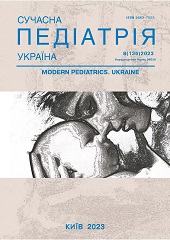International classification of diseases - 11: what do you need to know regarding upper respiratory tract injuries? Questions and answers
DOI:
https://doi.org/10.15574/SP.2023.136.7Keywords:
the International Classification of Diseases of the 11th Revision, children, upper respiratory tract, acute tonsillitis, recurrent tonsillitisAbstract
Purpose - to draw the attention of physicians to the structure of the International Classification of Diseases, the 11th Revision (ICD-11) for use in clinical practice using the example of nosological forms of tonsillitis.
The question-and-answer format provides up-to-date information on the main provisions of ICD-11, which was implemented worldwide from 01.01.2022. The attention of doctors is focused on the nosological approach in its structure. Using the example of acute and recurrent tonsillitis, it is shown how to use the new statistical classification of diseases correctly, and answers are given to the questions most often asked by practitioners when making a diagnosis according to this classification.
Conclusions. ICD-11, in addition to statistical needs, adds clinical needs and more, moving the ICD from a simple statistical database to a clinical classification for statistical use. Based on the most up-to-date clinical and epidemiological data and the results of double-blind, randomised, placebo-controlled trials, ICD-11 is synchronized with current clinical guidelines to help clinicians make informed decisions.
No conflict of interests was declared by the authors.
References
Derzhavnyi ekspertnyi tsentr MOZ Ukrainy. (2021). Hryp ta hostri respiratorni infektsii. URL: https://www.dec.gov.ua/mtd/gryp-ta-gostri-respiratorni-infekcziyi/.
Derzhavnyi ekspertnyi tsentr MOZ Ukrainy. (2021). Tonzylit. Klinichna nastanova, zasnovana na dokazakh. URL: https://www.dec.gov.ua/mtd/tonzylit/.
National Library of Medicine. (2013). Tonsillitis: Overview. Last Update: January 17, 2019; Next update: 2022. URL: https://www.ncbi.nlm.nih.gov/pubmedhealth/PMH0090038/.
Popovych VI, Koshel IV. (2018). Pain control in acute tonsillitis as a strategy of delayed antibiotics administration. Otolaryngology. 8; 4: 442-454
Popovych V, Koshel I, Malofiichuk A, Pyletska L et al. (2019). A randomized. open-label. Multicenter. Comparative study of therapeutic efficacy. Safety and tolerability of BNO 1030 extract. Containing marshmallow root, chamomile flowers, horsetail herb, walnut leaves, yarrow herb, oak bark, dandelion herb in the treatment of acute non-bacterial tonsillitis in children aged 6 to 18 years. American Journal of Otolaryngology. 40(2): 265-273. https://doi.org/10.1016/j.amjoto.2018.10.012; PMid:30554882
Popovych VI, Koshel IV, Malofiichuk OM, Pyletska LI et al. (2021). A randomized, open-label, multicentre, comparative study of therapeutic efficacy, preventive potential and tolerability of BNO 1030 extract, containing Althea root, Chamomile flowers, horsetail herb, walnut leaves, yarrow herb, oak bark, dandelion herb in the treatment of acute nonbacterial tonsillitis in children aged 6 to 18 years. Clin Phytosci. 7. Article: 15(2021). https://doi.org/10.1186/s40816-020-00240-6.
Popovych VI, Koshel IV, Malofiichuk OM, Pyletska LI. et al. (2021). Multicenter, Randomized, Open-Label, Comparative Study of Therapeutic Efficacy, Safety and Tolerability of BNO 1030 Application in the Technology of Delayed Prescription of Antibiotics in Patients with Severe Acute Tonsillitis. Ann Clin Otolaryngol. 6; 1: Article: 1049: 1-9. URL: http://www.remedypublications.com/open-access/multicenter-randomized-open-label-comparative-study-of-therapeutic-efficacy-safety-and-6845.pdf. https://doi.org/10.1101/2021.03.10.21253255
WHO. (2022). International Classification of Diseases 11th Revision. The global standard for diagnostic health information. URL: https://icd.who.int.
Downloads
Published
Issue
Section
License
Copyright (c) 2023 Modern pediatrics. Ukraine

This work is licensed under a Creative Commons Attribution-NonCommercial 4.0 International License.
The policy of the Journal “MODERN PEDIATRICS. UKRAINE” is compatible with the vast majority of funders' of open access and self-archiving policies. The journal provides immediate open access route being convinced that everyone – not only scientists - can benefit from research results, and publishes articles exclusively under open access distribution, with a Creative Commons Attribution-Noncommercial 4.0 international license (СС BY-NC).
Authors transfer the copyright to the Journal “MODERN PEDIATRICS. UKRAINE” when the manuscript is accepted for publication. Authors declare that this manuscript has not been published nor is under simultaneous consideration for publication elsewhere. After publication, the articles become freely available on-line to the public.
Readers have the right to use, distribute, and reproduce articles in any medium, provided the articles and the journal are properly cited.
The use of published materials for commercial purposes is strongly prohibited.

